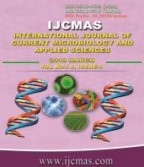


 National Academy of Agricultural Sciences (NAAS)
National Academy of Agricultural Sciences (NAAS)

|
PRINT ISSN : 2319-7692
Online ISSN : 2319-7706 Issues : 12 per year Publisher : Excellent Publishers Email : editorijcmas@gmail.com / submit@ijcmas.com Editor-in-chief: Dr.M.Prakash Index Copernicus ICV 2018: 95.39 NAAS RATING 2020: 5.38 |
The cole crops like cabbage, cauliflower, broccoli and brussel sprouts etc. are most important vegetables consumed all over the world, among them cabbage and cauliflower are economically vegetables in India. Most of the cruciferous vegetables are vulnerable to many insect pests. The Diamondback moth (DBM), Plutella xylostella Lineaus is the most serious pest in causing economic loss. DBM developed resistant to almost all the synthetic insecticides. Here we collected DBM population from Field of Rattihalli, Haveri district of the state Karnataka, India and reared for one generation. Isolation of cultivable gut bacteria was done from larvae of DBM using agar media and characterized each strain. Some of the strains were gram positive and some were gram negative. Isolate 3 was shown positive result and Isolate 10 was shown negative result for all biochemical tests (IMViC and Catalase). Bacterial genomic DNA were isolated and amplified in PCR with 16S rRNA primers (expected size 1000bp). Eight different bacterial isolates were obtained and identified at genus level such as Pseudomonas otitidis, Dyella japonica, Bacillus sp. Aneurinibacillus aneurinilyticus, Ralstonia solanacearum, Brachybacteria sp., Ralstonia picketti and Kocuria turfanensis. These studies suggest that there were bacterial diversity in DBM and these bacteria helps in development of P. xylostella.
 |
 |
 |
 |
 |